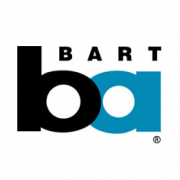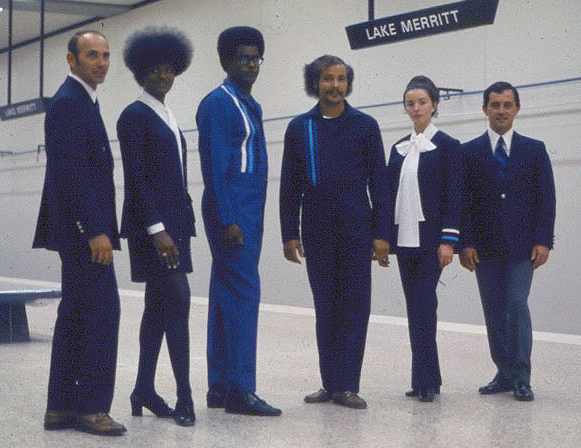-
Job Description
Marketing Statement
Ride BART to a satisfying career that lets you both: 1) make a difference to Bay Area residents, and 2) enjoy excellent pay, benefits, and employment stability. BART is looking for people who like to be challenged, work in a fast-paced environment, and have a passion for connecting riders to work, school and other places they need to go. BART offers a competitive salary, comprehensive health benefits, paid time off, and the CalPERS retirement program.
Job Summary
To be considered for the position, please submit your application through the provided link:
APPLY HERE
District Secretary
Bay Area Rapid Transit District (BART)
City of Oakland, California
Annual Salary: $202,957 - $226,000 DOE/DOQ
The Bay Area Rapid Transit District (BART) is seeking a seasoned and innovative professional to serve as its next District Secretary, a unique opportunity to contribute at the highest level of governance for one of the nation’s premier public transit agencies. The District Secretary oversees a staff of six that provides executive support for the District’s Board of Directors and various committees, ensures compliance with open meeting, public records, and election law, and upholds transparency, accountability, and integrity in the management of District records. This role offers the chance to lead meaningful modernization efforts, transformative culture and teambuilding initiatives, and support the Board of Directors and associated committees in navigating complex policy, legal, and operational challenges. The ideal candidate brings expertise in public agency governance, strong leadership and culture-building skills, and a passion for service. This is an exceptional opportunity for a driven and creative leader to make a lasting impact on the Bay Area’s most critical transit system. Lead the charge for modern, transparent, and effective governance in service to the Bay Area; apply today!
View the full recruitment brochure here: https://indd.adobe.com/view/9184a58e-241b-4a74-891f-6fd33f109596
Salary and Benefits: This position will receive an annual salary of $202,957 - $226,000 DOE/DOQ.
PLUS an attractive benefits package.
HOW TO APPLY: For first consideration, apply by August 25 at https://wbcp.applicantpool.com/jobs/1236130
SECURE THE DATES:
Round one interviews will be held virtually on September 29. Finalists will move forward to round two in-person interviews on October 9. Selected candidates must be available for both dates.
QUESTIONS?
Please contact your recruiter, Lauren Gerson-Greene, with any inquiries:- lauren@wbcpinc.com
- 541-664-0376 (Direct)
- 866-929-9227 (Toll Free)
Equal Employment Opportunity GroupBox1
The San Francisco Bay Area Rapid Transit District is an equal opportunity employer. Applicants shall not be discriminated against because of race, color, sex, sexual orientation, gender identity, gender expression, age (40 and above), religion, national origin (including language use restrictions), disability (mental and physical, including HIV and AIDS), ancestry, marital status, military status, veteran status, medical condition (cancer/genetic characteristics and information), or any protected category prohibited by local, state or federal laws.
The BART Human Resources Department will make reasonable efforts in the examination process to accommodate persons with disabilities or for religious reasons. Please advise the Human Resources Department of any special needs in advance of the examination by emailing at least 5 days before your examination date at employment@bart.gov .
Qualified veterans may be eligible to obtain additional veteran's credit in the selection process for this recruitment (effective Jan. 1, 2013). To obtain the credit, veterans must attach to the application a DD214 discharge document or proof of disability and complete/submit the Veteran's Preference Application no later than the closing date of the posting. For more information about this credit please go to the Veteran's Preference Policy and Application link at www.bart.gov/jobs .
The San Francisco Bay Area Rapid Transit District (BART) prides itself in offering best in class benefits packages to employees of the District. Currently, the following benefits may be available to employees in this job classification.
Highlights- Medical Coverage (or $350/month if opted out)
- Dental Coverage
- Vision Insurance (Basic and Enhanced Plans Available)
- Retirement Plan through the CA Public Employees’ Retirement System (CalPERS)
- 2% @ 55 (Classic Members)
- 2% @ 62 (PEPRA Members)
- 3% at 50 (Safety Members - Classic)
- 2.7% @ 57 (Safety Members - PEPRA)
- Reciprocity available for existing members of many other public retirement systems (see BART website and/or CalPERS website for details)
- Money Purchase Pension Plan (in-lieu of participating in Social Security tax)
- 6.65% employer contribution up to annual maximum of $1,868.65
- Deferred Compensation & Roth 457
- Sick Leave Accruals (12 days per year)
- Vacation Accruals (3-6 weeks based on time worked w/ the District)
- Holidays: 9 observed holidays and 5 floating holidays
- Life Insurance w/ ability to obtain additional coverage
- Accidental Death and Dismemberment (AD&D) Insurance
- Survivor Benefits through BART
- Short-Term Disability Insurance
- Long-Term Disability Insurance
- Flexible Spending Accounts: Health and Dependent Care
- Commuter Benefits
- Free BART Passes for BART employees and eligible family members.
-
ABOUT THE COMPANY
-

-
BART (Bay Area Rapid Transit)
Show moreThe BART story began in 1946. It began not by governmental fiat, but as a concept gradually evolving at informal gatherings of business and civic leaders on both sides of the San Francisco Bay. Facing a heavy post-war migration to the area and its consequent automobile boom, these people discussed ways of easing the mounting congestion that was clogging the bridges spanning the Bay. In 1947, a joint Army-Navy review Board concluded that another connecting link between San Francisco and Oakland would be needed in the years ahead to prevent intolerable congestion on the Bay Bridge. The link? An underwater tube devoted exclusively to high-speed electric trains.
Since 1911, visionaries had periodically brought up this Jules Verne concept. But now, pressure for a traffic solution increased with the population. In 1951, the State Legislature created the 26-member San Francisco Bay Area Rapid Transit Commission, comprised of representatives from each of the nine counties which touch the Bay. The Commission's charge was to study the Bay Area's long range transportation needs in the context of environmental problems and then recommend the best solution.
The Commission advised, in its final report in 1957, that any transportation plan must be coordinated with the area's total plan for future development. Since no development plan existed, the Commission prepared one itself. The result of their thoroughness is a master plan which did much to bring about coordinated planning in the Bay Area, and which was adopted a decade later by the Association of Bay Area Governments (ABAG).
The BART Concept is Born
The Commission's least-cost solution to traffic tie-ups was to recommend forming a five-county rapid transit district, whose mandate would be to build and operate a high-speed rapid rail network linking major commercial centers with suburban sub-centers.The Commission stated that, "If the Bay Area is to be preserved as a fine place to live and work, a regional rapid transit system is essential to prevent total dependence on automobiles and freeways."
Thus was born the environmental concept underlying BART. Acting on the Commission's recommendations, in 1957, the Legislature formed the San Francisco Bay Area Rapid Transit District, comprising the five counties of Alameda, Contra Costa, Marin, San Francisco and San Mateo. At this time, the District was granted a taxing power of five cents per $100 of assessed valuation. It also had authority to levy property taxes to support a general obligation bond issue, if approved by District voters. The State Legislature lowered the requirement for voter approval from 66 percent to 60 percent.
Between 1957 and 1962, engineering plans were developed for a system that would usher in a new era in rapid transit. Electric trains would run on grade-separated right-of-ways, reaching maximum speeds of 75-80 mph, averaging perhaps 45 mph, including station stops. Advanced transit cars, with sophisticated suspensions, braking and propulsion systems, and luxurious interiors, would be strong competition to "King Car " in the Bay Area. Stations would be pleasant, conveniently located, and striking architectural enhancements to their respective on-line communities.

BART employees in the 1970s.
Hundreds of meetings were held in the District communities to encourage local citizen participation in the development of routes and station locations. By midsummer, 1961, the final plan was submitted to the supervisors of the five District counties for approval. San Mateo County Supervisors were cool to the plan. Citing the high costs of a new system-plus adequate existing service from Southern Pacific commuter trains - they voted to withdraw their county from the District in December 1961.
With the District-wide tax base thus weakened by the withdrawal of San Mateo County, Marin County was forced to withdraw in early 1962 because its marginal tax base could not adequately absorb its share of BART's projected cost. Another important factor in Marin's withdrawal was an engineering controversy over the feasibility of carrying trains across the Golden Gate Bridge.
BART had started with a 16-member governing Board of Directors apportioned on county population size: four from Alameda and San Francisco Counties, three from Contra Costa and San Mateo, and two from Marin. When the District was reduced to three counties, the Board was reduced to 11 members: four from San Francisco and Alameda, and three from Contra Costa. Subsequently, in 1965, the District's enabling legislation was changed to apportion the BART Board with four Directors from each county, thus giving Contra Costa its fourth member on a 12-person Board. Two directors from each county, hence forth, were appointed by the County Board of Supervisors. The other two directors were appointed by committees of mayors of each county (with the exception of the City and County of San Francisco, whose sole mayor made these appointments).
The five-county plan was quickly revised to a three-county plan emphasizing rapid transit between San Francisco and the East Bay cities and suburbs of Contra Costa and Alameda counties. The new plan, elaborately detailed and presented as the "BART Composite Report, " was approved by supervisors of the three counties in July 1962, and placed on the ballot for the following November general election.
The plan required approval of 60 percent of the District's voters. It narrowly passed with a 61.2 percent vote District-wide, much to the surprise of many political experts who were confident it would fail. Indeed, one influential executive was reported to have said: "If I'd known the damn thing would have passed, I'd never have supported it. "
The voters approved a $792 million bond issue to finance a 71.5 mile high-speed transit system, consisting of 33 stations serving 17 communities in the three counties. The proposal also included another needed transit project: rebuilding 3.5 miles of the San Francisco Municipal Railway. The new line would link muni streetcar lines directly with BART and Market Street stations, and four new Muni stations would be built.
The additional cost of the transbay tube -- estimated at $133 million -- was to come from bonds issued by the California Toll Bridge Authority and secured by future Bay Area Bridge revenues. The additional cost of rolling stock, estimated at $71 million, was to be funded primarily from bonds issued against future operating revenues. Thus, the total cost of the system, as of 1962, was projected at $996 million. It would be the largest single public works project ever undertaken in the U.S. by the local citizenry.
After the election, engineers immediately started work on the final system designs, only to be halted by a taxpayer's suit filed against the District a month later. The validity of the bond election, and the legality of the District itself, were challenged. While the court ruled in favor of the District on both counts, six months of litigation cost $12 million in construction delays. This would be the first of many delays from litigation and time-consuming negotiations involving 166 separate agreements reached with on-line cities, counties, and other special districts. The democratic processes of building a new transit system would prove to be major cost factors that, however necessary, were not foreseen.
-
